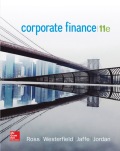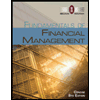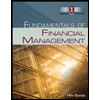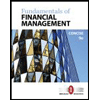
Concept explainers
a.
To identify: The company would be able or not to boost the profit, if it changes the cash management policy.
Cash management:
Cash management refers to that arrangement in which the company manages the cash inflows and
a.
Explanation of Solution
Statement to show the surplus or deficit
| Particulars |
Quarter 1 (million $) |
Quarter 2 (million $) |
Quarter 3 (million $) |
Quarter 4 (million $) |
| Beginning cash balance | 20 | 20 | 20 | 20 |
| Net |
5.80 | (24.64) | 3.64 | 25.40 |
| Less: New short-term investments | 6.14 | 22.53 | ||
| Income on short-term investment | 0.24 | 0.36 | ||
| Short-term investments sold | 18.04 | |||
| New short-term borrowings | 6.24 | |||
| Less: Interest on short-term borrowings | 0.19 | 0.08 | ||
| Short-term borrowing repaid | 3.45 | 0.279 | ||
| Ending cash balance | 19.90 | 20 | 20 | 22.51 |
| Minimum cash balance | 20 | 20 | 20 | 20 |
| Cumulative Surplus/deficit | (0.10) | 2.51 | ||
| Beginning short-term investments | 12 | 18.04 | ||
| Ending short-term investments | 18.04 | 22.53 | ||
| Beginning short-term debt | 0 | 0 | 6.24 | 2.79 |
| Ending short-term debt | 0 | 6.24 | 2.79 | 0 |
Table (1)
Compute the net cash cost
The interest income in Quarter 1 is $0.24.
The interest income in Quarter 2 is $0.36.
The interest expense in Quarter 3 is $0.19.
The interest expense in Quarter 4 is $0.08.
Formula to compute the net cash cost:
Substitute $0.24 for interest earned in Quarter 1, $0.36 for interest earned in Quarter 2, $0.19 for interest expense in Quarter 3 and $0.08 for interest expense in Quarter 4,
Working Note:
Statement to show the computation of net cash inflows:
| Particular |
Quarter 1 (million $) |
Quarter 2 (million $) |
Quarter 3 (million $) |
Quarter 4 (million $) |
| Beginning receivables | 34 | 52.50 | 45 | 61 |
| Add: Sales | 105 | 90 | 122 | 140 |
| Less: Collection of accounts | 86.5 | 97.50 | 106 | 131 |
| Ending receivables | 52.5 | 45 | 61 | 70 |
| Payment of accounts | 43.20 | 49.14 | 59.76 | 57.6 |
| Add: Wages, taxes, and expenses | 31.5 | 27 | 36.6 | 42 |
| Add: Capital expenditures | 40 | |||
| Add: Interest and dividends | 6 | 6 | 6 | 6 |
| Total cash disbursements | 80.70 | 122.14 | 102.36 | 105.60 |
| Total cash collections | 86.50 | 97.50 | 106 | 131 |
| Total ash disbursements | 80.70 | 122.14 | 102.36 | 105.60 |
| Net cash inflow | 5.80 | (24.64) | 3.64 | 25.40 |
Table (2)
Compute the interest income in Quarter 1:
Compute the interest income in Quarter 2:
Compute the interest expenditure in Quarter 3:
Compute the interest expenditure in Quarter 4:
Hence, the net cash cost is $0.33.
b.
To identify: The company would be able or not to boost the profit, if it changes the cash management policy.
b.
Explanation of Solution
Statement to show the surplus or deficit:
| Particulars |
Quarter 1 (million $) |
Quarter 2 (million $) |
Quarter 3 (million $) |
Quarter 4 (million $) |
| Beginning cash balance | 10 | 20 | 20 | 20 |
| Net cash inflow | 5.80 | (24.64) | 3.64 | 25.40 |
| Less: New short-term investments | 6.24 | 3.72 | 25.56 | |
| Income on short-term investment | 0.44 | 0.56 | 0.08 | 0.16 |
| Short-term investments sold | 24.08 | |||
| New short-term borrowings | ||||
| Less: Interest on short-term borrowings | ||||
| Short-term borrowing repaid | ||||
| Ending cash balance | 19.90 | 20 | 22.51 | |
| Less: Minimum cash balance | 10 | 10 | 10 | 10 |
| Cumulative Surplus/deficit | ||||
| Beginning short-term investments | 22 | 28.247 | 4.16 | 7.89 |
| Ending short-term investments | 28.24 | 4.16 | 7.89 | 33.6 |
| Beginning short-term debt | 0 | 0 | 0 | 0 |
| Ending short-term debt | 0 | 0 | 0 | 0 |
Table (3)
Compute the net cash cost
The interest income in Quarter 1 is $0.44.
The interest income in Quarter 2 is $0.56.
The interest income in Quarter 3 is $0.08.
The interest income in Quarter 4 is $0.16.
Formula to compute the net cash cost:
Substitute $0.44 for interest earned in Quarter 1, $0.56 for interest earned in Quarter 2, $0.08 for interest expense in Quarter 3 and $0.16 for interest expense in Quarter 4,
Working Note:
Compute the interest income in Quarter 1:
Compute the interest income in Quarter 2:
Compute the interest income in Quarter 3:
Compute the interest income in Quarter 4:
No, the company should not change the cash management policy as these policies give the more net cash cost and the company can consider any other factors but it is not necessary for it.
Company should not change its cash management policy as its net cash cost increases.
Want to see more full solutions like this?
Chapter 26 Solutions
EBK CORPORATE FINANCE
- What is a blue-chip stock? a) A stock with high volatilityb) A stock of a well-established, financially sound companyc) A newly launched IPO stockd) A stock with high dividends but low growtharrow_forwardNeed help in this question !properly What does “liquidity” refer to in finance? a) The profitability of a companyb) The ease of converting assets into cashc) The stability of incomed) The level of debtarrow_forwardI need help in this question! What does “liquidity” refer to in finance? a) The profitability of a companyb) The ease of converting assets into cashc) The stability of incomed) The level of debtarrow_forward
- Dont use chatgpt and give answer What does “liquidity” refer to in finance? a) The profitability of a companyb) The ease of converting assets into cashc) The stability of incomed) The level of debtarrow_forwardThe opportunity cost of holding cash is inversely related to the level of market interest rates. Question 9 options: True Falsearrow_forwardYour firm deals strictly with four customers. The average amount that each customer pays per month along with the collection delay associated with each payment is shown below. Given this information, what is the amount of the average daily receipts? Assume that every month has 30 days. Customer Item Amount Delay A $8,500 5 days B $12,000 2 days C $16,000 3 days D $3,600 2 days Question 8 options: $8,448 $1,337 $3,342 $1,408 $10,025arrow_forward
- Which of the following is true regarding cash management? Question 7 options: The basic objective in cash management is to keep the investment in cash as low as possible while still operating efficiently and effectively. Effective cash management results in minimization of the total interest earnings involved with holding cash. A cost of holding cash is the liquidity it gives the firm. A firm should decrease its cash holdings as long as the NPV of doing so is negative. A cost of holding cash is the interest income earned on the outstanding cash balance.arrow_forwardLow default risk is a characteristic of money market securities. Question 6 options: True Falsearrow_forwardJeep Corp. held large sums of cash during the mid-1990s primarily because it would need a large amount of cash in the event of a recession. This is a[n] _____ for holding cash. Question 5 options: Adjustment motive. Compensating balances motive. Speculative motive. Transactions motive. Precautionary motive.arrow_forward
- With respect to the workings of a lockbox system, the cheque clearing process begins before the company even knows the payments have been received. Question 4 options: True Falsearrow_forwardYou are considering implementing a lockbox system for your firm. The system is expected to reduce the collection time by 1.5 days. On an average day, your firm receives 250 checks with an average value of $400 each. The daily interest rate on Treasury bills is .02%. What is the anticipated amount of the daily savings if this system is implemented? Question 3 options: $30 $25 $15 $20 $10arrow_forwardDisbursement float is virtually eliminated when payments are made electronically. Question 2 options: True Falsearrow_forward
 Intermediate Financial Management (MindTap Course...FinanceISBN:9781337395083Author:Eugene F. Brigham, Phillip R. DavesPublisher:Cengage Learning
Intermediate Financial Management (MindTap Course...FinanceISBN:9781337395083Author:Eugene F. Brigham, Phillip R. DavesPublisher:Cengage Learning Fundamentals of Financial Management, Concise Edi...FinanceISBN:9781285065137Author:Eugene F. Brigham, Joel F. HoustonPublisher:Cengage Learning
Fundamentals of Financial Management, Concise Edi...FinanceISBN:9781285065137Author:Eugene F. Brigham, Joel F. HoustonPublisher:Cengage Learning Excel Applications for Accounting PrinciplesAccountingISBN:9781111581565Author:Gaylord N. SmithPublisher:Cengage Learning
Excel Applications for Accounting PrinciplesAccountingISBN:9781111581565Author:Gaylord N. SmithPublisher:Cengage Learning Fundamentals of Financial Management (MindTap Cou...FinanceISBN:9781285867977Author:Eugene F. Brigham, Joel F. HoustonPublisher:Cengage Learning
Fundamentals of Financial Management (MindTap Cou...FinanceISBN:9781285867977Author:Eugene F. Brigham, Joel F. HoustonPublisher:Cengage Learning Fundamentals of Financial Management, Concise Edi...FinanceISBN:9781305635937Author:Eugene F. Brigham, Joel F. HoustonPublisher:Cengage Learning
Fundamentals of Financial Management, Concise Edi...FinanceISBN:9781305635937Author:Eugene F. Brigham, Joel F. HoustonPublisher:Cengage Learning




